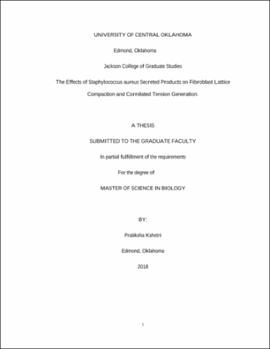| dc.contributor.advisor | Vaughn, Melville B. | |
| dc.contributor.author | Pratiksha, Kshetri | |
| dc.date.accessioned | 2020-07-09T14:41:43Z | |
| dc.date.available | 2020-07-09T14:41:43Z | |
| dc.date.issued | 2018 | |
| dc.identifier.other | (AlmaMMSId)9982642278402196 | |
| dc.identifier.uri | https://hdl.handle.net/11244/325139 | |
| dc.description.abstract | Chronic wounds such as diabetic foot ulcers, pressure ulcers, venous leg ulcers have become a worldwide problem, as they fail to heal in a regular period due to the presence of an extended inflammatory stage. Bacterial infection is one contributing factor that impairs the wound healing process. The ability of the dermal fibroblast to migrate, proliferate and differentiate is the critical factor for the normal progression of wound healing. Studies have shown that chronic wound biofilms colonize the dermal tissue which makes it important to investigate dermal fibroblast behavior in the presence of bacterial secreted products. The objective of the study was to determine if products secreted by Staphylococcus aureus in planktonic or biofilm phenotypic states would play a role in wound chronicity by affecting fibroblast functions. A 3-dimensional collagen lattice model was used to study fibroblast tension generation day by day with the presence or absence of the bacterial secretion products. Using this model, we conducted our observation by measuring height and fibroblast tension generation of collagen lattices and followed by immunostaining the lattices to identify structural changes. On each day of 5-day height measurements of fibroblast lattices, I observed that planktonic conditioned medium (PCM)-treated lattices had the most significant effect on compaction compared to biofilm conditioned medium (BCM), control and TGF-beta treatments. Similarly, when lattices were released PCM inhibited the lattice contraction followed by BCM. Lattices treated with TGF- beta were found to have the highest anchored compaction and were very contractile when released. Compaction and contraction were associated with the number of differentiated myofibroblasts and total cell number with respect to the treatment. Fibroblast lattices exposed to PCM showed no presence of myofibroblasts. Our findings are highly relevant to the medical field curing chronic wounds and should help the scientific community understand chronic wound healing at the cellular level. | |
| dc.rights | All rights reserved by the author, who has granted UCO Chambers Library the non-exclusive right to share this material in its online repositories. Contact UCO Chambers Library's Digital Initiatives Working Group at diwg@uco.edu for the permission policy on the use, reproduction or distribution of this material. | |
| dc.subject.lcsh | Skin | |
| dc.subject.lcsh | Staphylococcus aureus | |
| dc.subject.lcsh | Fibroblasts | |
| dc.subject.lcsh | Biofilms | |
| dc.subject.lcsh | Wound healing | |
| dc.subject.lcsh | Biofilms | |
| dc.subject.lcsh | Fibroblasts | |
| dc.subject.lcsh | Skin | |
| dc.subject.lcsh | Staphylococcus aureus | |
| dc.subject.lcsh | Wound healing | |
| dc.title | The effects of Staphylococcus aureus secreted products on fibroblast lattice compaction and correlated tension generation. | |
| dc.type | Academic theses | |
| dc.contributor.committeeMember | Brennan, Robert | |
| dc.contributor.committeeMember | Kotturi, Hari S. | |
| dc.thesis.degree | M.S., Biology | |
| dc.subject.keywords | Biofilm | |
| dc.subject.keywords | Chronic wound | |
| dc.subject.keywords | Fibroblast | |
| dc.subject.keywords | Myofibroblast | |
| dc.subject.keywords | Planktonic | |
| dc.subject.keywords | Tension generation | |
| dc.identifier.oclc | (OCoLC)1099801862 | |
| uco.group | UCO - Graduate Works and Theses::UCO - Theses | |
| thesis.degree.grantor | Jackson College of Graduate Studies. | |
